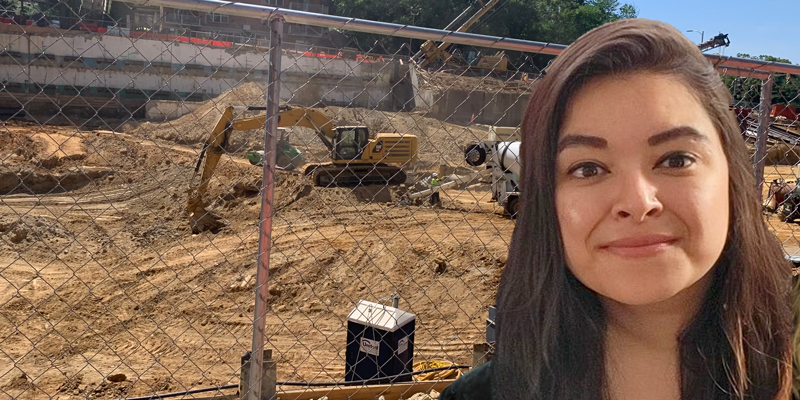The Lure of Cement
This article is part of a series of pieces on environmental topics that Physics is publishing to celebrate Earth Day (April 22). See also: Research News: Breaking Barriers to Polymer Recycling; Arts & Culture: Serenading a Troubled Ocean; Opinion: Renewable Energy’s Intermittency is Not a Showstopper; News Feature: The Answer is Blowing in the Turbine.
Ankita Gangotra can’t remember a time when she wasn’t interested in science. As a child, her favorite playtime activity was to conduct experiments described in a science encyclopedia that her parents gifted her. She also notes that in India, where she grew up, science is an integral part of everyone’s education. “In India, you don’t opt into science,” she says. “If the subject doesn’t interest you, you have to opt out.”
Gangotra started her physics career with a Ph.D. in which she developed a tool for monitoring the mechanical properties of individual soft particles, such as biological cells or plastic microspheres. Her career then took an unexpected turn. Rather than taking the traditional academic route, Gangotra moved into policy, a move inspired by work she’d done helping to organize the 2017 March for Science held in Auckland, New Zealand. Working with the New Zealand government’s chief science advisor, she examined policy options for improving equity, diversity, and inclusion within the country’s science institutions. Gangotra then joined an environmental startup, where she worked on projects related to environmental sustainability, such as sustainable agriculture. That job cemented her interest in working on environmental policy issues. But when she thought she was about to leave academia for good, a postdoctoral opportunity to work on low-carbon construction material caught her attention. “I saw an opportunity to combine my training as a materials scientist with climate policy research,” she says. “I couldn’t pass it up.”
Physics spoke to Gangotra, who currently works as a post-doc at Georgetown University, to learn more about what it’s like to work on science policy and why the prospect of working on cement brought her back to academia.
All interviews are edited for brevity and clarity.
Why did working on cement make you change your mind about being an academic?
My interests lie in developing climate-related policy, and cement is an interesting material to study when it comes to climate change because of its wide use and its carbon-intensive production process.
We know that by 2060, population growth and urbanization will mean that the world will need to double its current building stock. Consumption of cement is thus only going to increase. Today, cement production releases about 8% of the world’s carbon dioxide emissions—if the cement industry were a country, it would be the third largest polluter after China and the US. But decarbonizing cement is a complex problem.
How so?
Reducing its carbon dioxide emissions isn’t straightforward. That’s because the chemical reactions needed to make “clinker,” the solid intermediary that acts as cement’s glue, release a huge amount of carbon dioxide. Alone, they are responsible of 50% of cement’s carbon footprint.
What are the options, then, for reducing cement’s carbon dioxide emissions?
One approach is to improve energy efficiency at cement plants, so that the kilns used to make clinker require less power to operate. Another is to use biomass or waste fuels, rather than fossil fuels, to power the kilns. In the future, carbon-capture technologies at plants could also help.
However, to make a bigger impact now, the amount of clinker in cement needs to be reduced, the amount of cement in concrete—which is cement combined with water, sand, and gravel, and is the material used to make buildings and roads—needs to go down, or each individual building project needs to use less concrete. That last solution is one I recently started looking into.
How could you reduce concrete usage without altering a building’s robustness, for example?
One option currently under investigation is to 3D print concrete structures, such as low-rise buildings and bridges. 3D printing typically requires less material to make the same object because it involves less waste—no framework needs to be pre-built to hold the concrete in place while it sets. Furthermore, the technology can also be used to make complex structures using fewer materials. 3D printing also reduces construction times and labor requirements.
Unfortunately, though, the carbon footprint of current 3D-printable concrete can be higher than conventional concrete—it requires a higher clinker content to give it the right properties for printing. But I still think that there is potential for 3D printing to be part of the solution for reducing cement and concrete’s carbon footprints: 3D printing technologies are relatively new and there’s still room for improving them in a way that reduces their clinker-content requirement.
On a different topic, for those unfamiliar with policy development, what does a work day look like?
My project is associated with two departments at Georgetown—physics and foreign service. My day typically starts in the physics department, where I might be listening to science talks or reading science papers. Then I’ll pop over to the foreign service building to attend a policy seminar or to take part in a discussion on industrial policies. My days are always different, but that variety keeps it interesting.
What advice would you give to other scientists who want to transition into public policy?
For US citizens and residents, it’s relatively easy: you can sign up for a science policy training program, such as the ones offered by AAAS or the Department of Energy. For everyone else, the pathway may be more informal. You must find your own route to gaining the skills needed to get hired for a policy job. I wouldn’t be in my current position if I hadn’t worked for the New Zealand government. Gaining that experience requires networking and cold-emailing places where you might like to work. That can be daunting, but don’t let it stop you—more scientists really need to get involved in policy making.
–Katherine Wright
Katherine Wright is the Deputy Editor of Physics Magazine.





